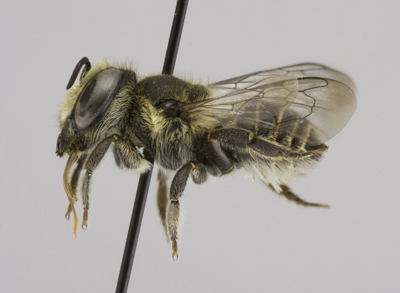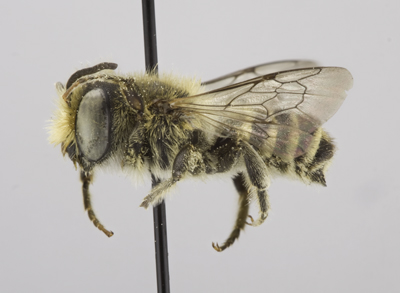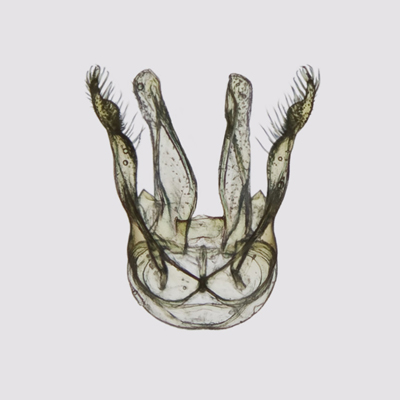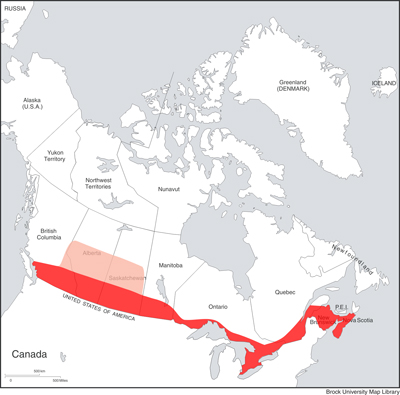
6. Megachile (Eutricharaea) rotundata (Fabricius, 1793)
Megachile rotundata Female |
Megachile rotundata Male |
Apis rotundata Fabricius, 1793. Entom. system. 2: 332 (♂).
Apis pacifica Panzer, 1798. Faunae Ins. German. 55: 16 (♀).
Megachile imbecilla Gerstaecker, 1869. Stettin. Entomol. Ztg. 30: 359 (♀).
Diagnosis.The female of M. rotundata can be recognized by the combination of dense, white apical fasciae on the metasomal sterna (i.e., beneath the scopa), the dull, impunctate fovea-like patches laterally on T2, a nearly straight clypeal margin, and the scopa entirely pale on S4 with some pale hairs basally on S5. It is most similar to M. apicalis. Females of M. apicalis have the apical edge of clypeus angulate medially, and the scopa black apically and laterally on S4, and entirely so on S5 and S6. The male of M. rotundata is recognized by the dull, lateral, impunctate areas on T2 only, and tarsomeres 4 and 5 largely yellow. They are most similar to M. apicalis. Males of M. apicalis have dull, lateral, impunctate areas on both T2 and T3, and mostly dark tarsomeres (which may be yellowish basally).
FEMALE: Length 8-9 mm.
Head:
Figure M6: Megachile rotundata female mandible |
1) compound eyes very slightly convergent below; lateral ocelli subequally distant from eyes and margin of vertex, 2) clypeal margin nearly straight, with very shallow and rather short emarginate area on each side of the central impunctate edge, 3) mandibles 4-dentate, with cutting edge between 3rd and 4th teeth, margin of 4th tooth very slightly angulate (Figure M6), 4) gena narrower than compound eye (4:7), 5) punctures of vertex fine and close but quite deep and distinct, becoming somewhat more shallow and obscure on gena, irregularly so below; frons densely rugose, supraclypeal area closely and rather coarsely punctate on each side, with some shining, impunctate spaces apically in centre, clypeus with a very narrow, obscure, shining and sparsely punctate median line, punctures on each side rather coarse and densely crowded, 6) pubescence yellowish-white, rather short on face, rather dense around antennae and on paraocular area, sparse, erect and rather elongate on vertex, with dark hairs intermixed; pubescence of gena more whitish, short above, somewhat more elongate below, 7) F1 and F2 quadrate and subequal in length, slightly shorter than pedicel, which is longer than broad (2:1.5), remaining flagellomeres slightly longer, but almost quadrate, apical flagellomere longer than broad (5:3).
Mesosoma:
1) pubescence short, white laterally and posteriorly, quite dense around pronotal lobes and behind wing bases, more yellowish, very short and inconspicuous on mesoscutum, scutellum with more elongate, erect, yellowish hairs, 2) dorsal surface densely punctate throughout, punctures rather coarse in centre, lateral faces of pleura somewhat shining, with punctures somewhat shallower but contiguous, becoming somewhat finer and crowded above, larger and sparser below, propodeum somewhat more shining, punctures irregular, minute and vague, triangle dull and impunctate, becoming somewhat rugose basally, 3) all basitarsi shorter and somewhat narrower than their tibiae, spurs yellow, 4) tegula brownish-black with only a few, scattered, minute and obscure punctures, 5) wings subhyaline, veins black.
Metasoma:
1) disc of T2 with a dull, sublateral, impunctate area, fovea-like, distinct from remaining surface of disc; T2-T5 with apical margins rather abruptly depressed laterally but not medially, with entire, whitish, apical fasciae that are quite dense laterally, narrow medially; T1 with rather copious but sparse, elongate, whitish pubescence that becomes rather dense laterally, T2-T4 with very short, black, discal pubescence, T2-T6 with conspicuous, black hairs evident on each side in dorsal view, T6 nearly straight in profile, with numerous, suberect, black hairs evident on disc, without pale tomentum; punctures fine and close on the more basal terga, punctures of T3-T5 quite deep, distinct, and well separated; T6 surface very finely and quite densely punctate, 2) scopa entirely pale on S2-S4, S5 with scopal hairs pale basally, but more or less black apically and laterally, entirely black on S6; the more basal sterna very closely and rather finely punctate, punctures becoming somewhat more coarse and sparse on the more apical sterna; apical margins narrowly depressed, distinctly white fasciate beneath scopa.
MALE: Length 6-8 mm.
Head:
1) compound eyes convergent below; lateral ocelli subequally distant from eyes and margin of vertex, 2) median third of clypeal margin slightly incurved, 3) mandibles 3-dentate, lower process slender and acute, subbasal in position, 4) gena considerably narrower than compound eye (3:4), 5) punctures of vertex very close, rather fine but deep and distinct, these becoming somewhat finer and more shallow on gena; face below ocelli rather finely rugosopunctate, clypeus very finely and densely rugose, 6) pubescence of face and vertex yellow, dense around antennae and over lower portion of face, supraclypeal area with very dense, subappressed, upwardly directed hairs that completely hide surface, clypeal pubescence more erect, slightly down curved at tips, but largely obscuring surface, that on vertex sparse and erect, yellowish on gena above, becoming white, very long and dense below, 7) F1 about as long as broad, and subequal in length to pedicel, remaining flagellomeres longer than broad (5:3), apical flagellomere slender and elongate (7:3).
Mesosoma:
1) pubescence whitish, quite dense laterally and posteriorly, yellowish or whitish on mesoscutum, more elongate and erect on scutellum, 2) dorsal surface dull, surface densely and finely rugosopunctate, punctures of pleura somewhat coarser but densely crowded; propodeum rather smooth, with only exceedingly minute, sparse punctures, triangle dull and impunctate, 3) front coxal spine spatulate, rather broad and quite short, densely white pubescent posteriorly, coxa rather densely white pubescent laterally but largely bare toward inner side, no red bristles evident; front tarsus slender and simple, with a very short but rather dense, posterior fringe, tarsomeres 2 and 3 yellow at base, 4 and 5 largely yellow; front tibia dark, and front femur largely dark on posterior face, apical half of anterior face quite conspicuously yellow, lower margin only obscurely carinate and yellow not invading margin of posterior face; mid tibial spur well developed, mid and hind tarsi slender and simple, spurs yellow, 4) tegula brownish-black, minutely and closely punctate, 5) wings subhyaline, somewhat clouded apically, veins black.
Metasoma:
1) disc of T2 with dull sublateral, impunctate areas; basal grooves of T3 and T4 very shallow, subcarinate with a basal fasciae arising from under the edge of the carina; apical margins of T2-T5 rather deeply depressed laterally but not medially, with dense, complete, whitish or yellowish fasciae; T1 with copious, erect, entirely pale pubescence, becoming very dense laterally, disc of T2 rather densely covered with suberect, pale hairs that do not hide surface, T3 and T4 with shorter, more obscure, suberect pubescence, which is dark at least in part; punctures of terga close medially, fine on T2 and somewhat coarser on T3 and T4, T5 densely pale tomentose across base, with suberect, somewhat darker hairs apically, apical margin deeply depressed laterally but not in centre, punctures rather irregular but quite coarse and close, apical margin not fasciate; T6 very densely pale tomentose, largely hiding surface, carina very low and irregularly crenulate, median emargination very obscure, apical margin without distinct median teeth, and lateral angles very obscure; T7 transverse, flattened, not at all produced medially, 2) S1-S4 exposed, finely and rather closely punctate, punctures becoming very fine apically on S4, S2 and S3 quite deeply depressed apically, yellowish hyaline, with quite dense fringes of rather elongate, white hairs.
Genitalia: Figure G6.
|
Figure G6: Megachile rotundata genitalia |
Discussion:
Although its presence in the Maritime Provinces may be a result of its ongoing commercial release for pollination of lowbush blueberry (Javorek 1996; see Sheffield 2008), trap-nest surveys in NS (Sheffield et al. 2008) have recovered M. rotundata in areas outside of the range of this crop. Therefore, it may have established naturally or from previous introductions in the province prior to the 1990’s. Its cold-hardiness probably limits its natural distribution in Canada (Krunic 1971; Krunic and Salt 1971; Sheffield 2008), and distributional records in more northern areas are probably a reflection of where it has been released for agricultural purposes: alfalfa pollination in the west and lowbush blueberry in the east. This species is a cavity nester, and accepts trap nests (Table 1). Pitts-Singer and Cane (2011) provide a comprehensive review of the management history of this important commercial pollinator; Trostle and Torchio (1994) discussed its nesting behaviour and development.
Distribution:
Introduced into Atlantic Canada as a pollinator of lowbush blueberry, established populations in NS, and from southern QC-BC (see Map 6). Also used in NL, though not established (see Map 6).
|
Map 6: Canadian distribution of Megachile rotundata |




